p.103
p.109
p.115
p.119
p.123
p.129
p.133
p.138
p.142
Influence of Atmospheric Gases Present in the Pores of MCM-41 on Lifetime of Ortho-Positronium
Abstract:
The modification of the extended Tao-Eldrup model accounting ortho-positronium quenching in air is presented. Taking into account quenching by oxygen molecules adsorbed on the surface of porous material gives reasonable agreement between results of the model and the experimental positron annihilation lifetime spectroscopy data. Pore size distributions calculated using this model from the spectra for MCM 41 mesoporous sieve obtained in air, oxygen or vacuum are compared and discussed taking into account effect of ortho-positronium migration from small open pores to the larger ones. The rates of ortho-positronium quenching by air (47.2 µs-1 MPa 1), oxygen (220 µs-1 MPa-1) or nitrogen (1.7 µs-1 MPa-1) obtained from pressure dependences of the lifetimes observed in MCM 41 agree reasonably with the experimental results of other authors, if the correction for oxygen adsorbed on the surface is applied.
Info:
Periodical:
Pages:
123-128
Citation:
Online since:
December 2010
Authors:
Keywords:
Price:
Сopyright:
© 2011 Trans Tech Publications Ltd. All Rights Reserved
Share:
Citation:


